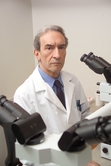Cytogenetic analysis of 434 consecutively ascertained specimens of non‐Hodgkin's lymphoma: Correlations between recurrent aberrations, histology, and exposure to cytotoxic treatment Journal Article
| Authors: | Offit, K.; Jhanwar, S. C.; Ladanyi, M.; Filippa, D. A.; Chaganti, R. S. K. |
| Article Title: | Cytogenetic analysis of 434 consecutively ascertained specimens of non‐Hodgkin's lymphoma: Correlations between recurrent aberrations, histology, and exposure to cytotoxic treatment |
| Abstract: | Cytogenetic abnormalities in non‐Hodgkin's Lymphoma (NHL) provide a model system for the analysis of the role of multiple genomic aberrations in human malignancy. In order to define correlations with histology, tumor evolution, and the effects of genotoxic exposure, Cytogenetic analysis was performed on 434 specimens of NHL derived from 423 patients consecutively ascertained over a 5‐year period (1984–1989). Six recurring translocations (RT) were observed: t(14;18)(q32;q21), t(8;14)(q24;q32), t(11;14)(q13;q32), t(3;22)(q27;11), t(2;5)(p23;q35), and t(1;6)(q21;q25). No translocation was specific to a single histologic subtype. Other structural chromosome abnormalities were analyzed according to break site; groups of related breaks were considered together for statistical analysis. Recurring other structural and numerical aberrations (ROA) encountered in >10% of specimens included rearrangements with breaks at bands 1p32–36, 1q21–23, 6q21–25, and trisomies of chromosomes 7 and 12. ROA with one of these breaks or numerical abnormalities were the sole abnormalities in at least two cases. Correlations were observed among ROA and between ROA and histologic subtypes. Trisomy 7, breaks at 1q21–23, 1p32‐36, 6q21–25, and 7q32 were associated with t(14;18); trisomy 18 was associated with trisomy 3; and structural abnormalities of chromosome 17 were associated with breaks at 1p32‐36 and 6q21–25. Trisomy 7 and trisomy 12 were more frequent in t( 14;18)‐bearing intermediate to high grade tumors compared to low grade tumors. Trisomy 12 and breaks at band 1p22 were associated with large cell diffuse lymphomas. Incidence rates of reciprocal translocations, ROA, and measures of karyotypic complexity, including number of breakpoints and marker chromosomes were compared in pretreatment and posttreatment samples. Karyotypic complexity was greater in the posttreatment samples, reflecting an increased frequency of nonrecurring and low incidence aberrations. These results better define the association of genomic aberrations and tumori‐genesis, histologic transformation, and tumor progression. Copyright © 1991 Wiley‐Liss, Inc., A Wiley Company |
| Keywords: | cancer chemotherapy; human tissue; human cell; major clinical study; radiotherapy; cytotoxicity; chromosome aberration; nonhodgkin lymphoma; gene rearrangement; lymphoma, non-hodgkin; chromosome translocation; chromosome aberrations; alkylating agents; karyotyping; aneuploidy; trisomy; chromosome banding; ploidies; chromosome disorders; human; article; support, non-u.s. gov't; support, u.s. gov't, p.h.s.; translocation (genetics) |
| Journal Title: | Genes Chromosomes and Cancer |
| Volume: | 3 |
| Issue: | 3 |
| ISSN: | 1045-2257 |
| Publisher: | Wiley Periodicals, Inc |
| Date Published: | 1991-05-01 |
| Start Page: | 189 |
| End Page: | 201 |
| Language: | English |
| DOI: | 10.1002/gcc.2870030304 |
| PUBMED: | 1868033 |
| PROVIDER: | scopus |
| DOI/URL: | |
| Notes: | Article -- Export Date: 27 September 2019 -- Source: Scopus |
Altmetric
Citation Impact
BMJ Impact Analytics
Related MSK Work







